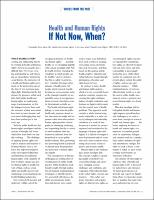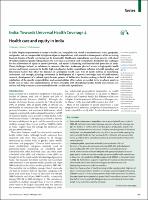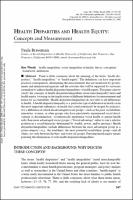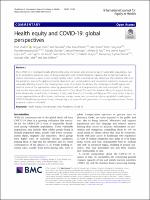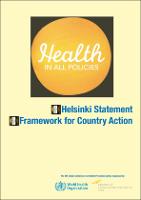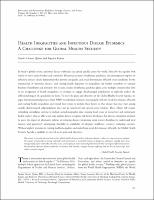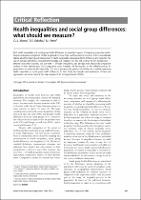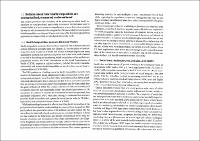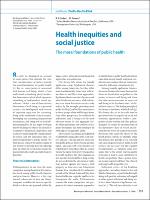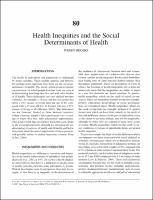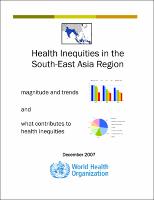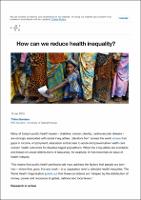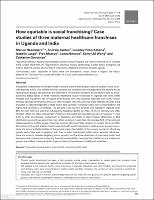Browsing by Title
Now showing items 99-118 of 229
-
Health and health-care systems in southeast Asia: diversity and transitions
(The Lancet, 2011-01-25)
Southeast Asia is a region of enormous social, economic, and political diversity, both across and within countries, shaped by its history, geography, and position as a major crossroad of trade and the movement of goods and services. These factors have not only contributed to the disparate health status of the region's diverse populations, but also to the diverse nature of its health systems, which are at varying stages of evolution. Rapid but inequitable socioeconomic development, coupled with differing rates of demographic and epidemiological ... -
Health and Human Rights: If not now than when?
(American Journal of Public Health, 2006-11) -
Health care and equity in India
(The Lancet, 2011)
In India, despite improvements in access to health care, inequalities are related to socioeconomic status, geography, and gender, and are compounded by high out-of-pocket expenditures, with more than three-quarters of the increasing financial burden of health care being met by households. Health-care expenditures exacerbate poverty, with about 39 million additional people falling into poverty every year as a result of such expenditures. We identify key challenges for the achievement of equity in service provision, and equity in financing and ... -
Health care systems in low- and middle-income countries
(Massachusetts Medical Society, 2014-02-06)
This review draws on what is now quite an extensive literature on the deficiencies of health care systems and on the Health Systems Evidence database. However, the poor quality and uneven coverage of evidence on the strengthening of health care systems means that evidence of deficiencies is stronger than evidence of remedies. Moreover, the specific circumstances of individual countries strongly influence both decisions about which approaches might be relevant and their success, so any generalizations made from health systems research in particular ... -
HEALTH DISPARITIES AND HEALTH EQUITY: Concepts and Measurement
(Annual Review of Public Health, 2006)
There is little consensus about the meaning of the terms “health disparities,” “health inequalities,” or “health equity.” The definitions can have important practical consequences, determining the measurements that are monitored by governments and international agencies and the activities that will be supported by resources earmarked to address health disparities/inequalities or health equity. This paper aims to clarify the concepts of health disparities/inequalities (used interchangeably here) and health equity, focusing on the implications of ... -
Health equity and COVID-19: global perspectives
(2020-12)
The COVID-19 is disproportionally affecting the poor, minorities and a broad range of vulnerable populations, due to its inequitable spread in areas of dense population and limited mitigation capacity due to high prevalence of chronic conditions or poor access to high quality public health and medical care. Moreover, the collateral effects of the pandemic due to the global economic downturn, and social isolation and movement restriction measures, are unequally affecting those in the lowest power strata of societies. To address the challenges to ... -
Health in all policies: Helsinki statement. Framework for country action
(World Health Organization, 2021)
The participants to the 8th Global Conference on Health Promotion endorsed the Helsinki Statement on Health in All Policies In which they prioritize health and equity as a core responsibility of governments to its peoples, affirm the compelling and urgent need for effective policy coherence for health and well-being and recognize that this will require political will, courage and strategic foresight. The participants of the Conference call on governments to fulfill their obligations to their people’s health and wellbeing by taking a number of ... -
Health Inequalities and Infectious Disease Epidemics: A Challenge for Global Health Security
(2014)
In today's global society, infectious disease outbreaks can spread quickly across the world, fueled by the rapidity with which we travel across borders and continents. Historical accounts of influenza pandemics and contemporary reports on infectious diseases clearly demonstrate that poverty, inequality, and social determinants of health create conditions for the transmission of infectious diseases, and existing health disparities or inequalities can further contribute to unequal burdens of morbidity and mortality. Yet, to date, studies of influenza ... -
Health inequalities and social group differences: what should we measure?
(Bulletin of the World Health Organization, 1999)
Both health inequalities and social group health differences are important aspects of measuring population health. Despite widespread recognition of their magnitude in many high- and low-income countries, there is considerable debate about the meaning and measurement of health inequalities, social group health differences and inequities. The lack of standard definitions, measurement strategies and indicators has and will continue to limit comparisons Ð between and within countries, and over time Ð of health inequalities, and perhaps more ... -
Health inequalities: critical perspectives
(Oxford University Press, 2016)
This section provides a brief summary of the main ways in which health in-equalities are conceptualized, particularly in terms of the indicators used to stratify health. It is by no means a comprehensive account but rather considers the ways in which researchers focusing on the UK have tended to conceptualize health inequalities over the past 30 years and some of the key chalenges to these approaches (critiques which are developed later in this book). -
Health inequities and social justice: The moral foundations of public health
(Bundesgesundheitsblatt - Gesundheitsforschung - Gesundheitsschutz, 2008)
Recently we argued that social justice is concerned with human well-being, which is best understood as involving plural, irreducible dimensions, each of which represents something of independent moral significance. Health is one of these distinct dimensions of well-being, as is personal security, the development and exercise of cognitive capacities for reasoning, living under conditions of social respect, developing and sustaining deep personal attachments, and being able to lead self-determining lives. In this paper, we address why considerations ... -
Health Inequities and the Social Determinants of Health
(John Wiley & Sons, Ltd, 2006)
The health of individuals and populations is influenced by many variables. These include genetics and biology, but perhaps more important than these are the social determinants of health. The social, political and economic circumstances in which people live their lives are critical in determining how long they live and with what burden of ill health. These differences are very marked between countries, for example a 15-year-old boy in Lesotho has about a 10% chance of living until the age of 60, compared with a 15-year-old boy in Sweden who has ... -
Health, Disability and the Capability Approach: An Introduction
(Journal of Human Development and Capabilities, 2015)
This special issue of the Journal of Human Development and Capabilities focuses on two areas of substantial and growing importance to the human development and capability approach: disability and health. The research on disability, health and the capability approach has been diverse in the topics it covers, and the conceptual frameworks and methodologies it uses, beginning over a decade and a half ago in health (Ruger 1998) and more than a decade ago in disability (Baylies 2002).1 We are pleased to share a set of articles in these two areas. ... -
HEALTH, VITAL GOALS, AND CENTRAL HUMAN CAPABILITIES
(Bioethics, 2013)
I argue for a conception of health as a person’s ability to achieve or exercise a cluster of basic human activities. These basic activities are in turn specified through free-standing ethical reasoning about what constitutes a minimal conception of a human life with equal human dignity in the modern world. I arrive at this conception of health by closely following and modifying Lennart Nordenfelt’s theory of health which presents health as the ability to achieve vital goals. Despite its strengths I transform Nordenfelt’s argument in order to ... -
How can we reduce health inequality?
(2015-01-19) -
How Countries in Southeast Asia are Working Together to Accelerate Human Capital Development
(THE WORLD BANK, 2019) -
How equitable is social franchising? Case studies of three maternal healthcare franchises in Uganda and India
(Oxford University Press in association with The London School of Hygiene and Tropical Medicine, 2018-04-01)
Substantial investments have been made in clinical social franchising to improve quality of care of private facilities in low- and middle-income countries but concerns have emerged that the benefits fail to reach poorer groups. We assessed the distribution of franchise utilization and content of care by socioeconomic status (SES) in three maternal healthcare social franchises in Uganda and India (Uttar Pradesh and Rajasthan). We surveyed 2179 women who had received antenatal care (ANC) and/or delivery services at franchise clinics (in Uttar Pradesh ... -
Human rights and asian values
(1997)
In 1776, just when the Declaration of Independence was being adopted in this country, Thomas Paine complained, in Common Sense, that Asia had “long expelled” freedom. In this lament, Paine saw Asia in company with much of the rest of the world (America, he hoped, would be different). Singapore warned that “universal recognition of the ideal of human rights can be harmful if universalism is used to deny or mask the reality of diversity.” The Chinese delegation played a leading role in emphasizing regional differences and in making sure that the ...


